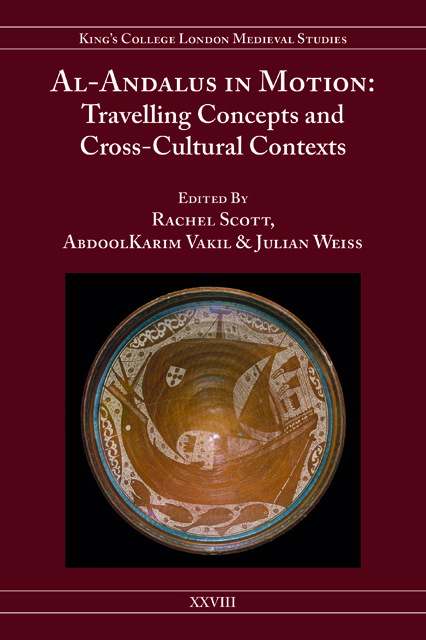Book contents
- Frontmatter
- Contents
- List of Illustrations
- Acknowledgements
- Notes on Contributors
- Part I Departure Points
- Part II Translating Al-Andalus: Travelling across Languages
- Part III (Re)Visions of Al-Andalus in Diaspora and Exile
- Part IV Andalusi Space as Node and Utopia: Europe, Islam, Empire
- Part V Al-Andalus and the Politics of Religious Identity
- Part VI Legacies, Landscapes and ‘Travel Buildings’
- Epilogue
- Index
10 - The ‘Orient’ Express: The Neo-Mudéjar Train Station in Toledo and the Spanish Debate on National Architectural Style
Published online by Cambridge University Press: 02 June 2023
- Frontmatter
- Contents
- List of Illustrations
- Acknowledgements
- Notes on Contributors
- Part I Departure Points
- Part II Translating Al-Andalus: Travelling across Languages
- Part III (Re)Visions of Al-Andalus in Diaspora and Exile
- Part IV Andalusi Space as Node and Utopia: Europe, Islam, Empire
- Part V Al-Andalus and the Politics of Religious Identity
- Part VI Legacies, Landscapes and ‘Travel Buildings’
- Epilogue
- Index
Summary
Modernity travelled Europe by rail, and when it reached Toledo, the capital of Visigothic Iberia in the early Middle Ages, Queen Isabel II was on hand in 1858 to inaugurate the new train station with great pomp. The celebration, described in the local press, included a solemn religious ceremony, with a blessing of the decorated locomotive in which the queen arrived from Madrid in the company of her husband, the Prince of Asturias (del Cerro Malagon 1992: 64). In retrospect it is an almost comic image, but it attests to the need of a triumphant modernity to accommodate the past that it was in the process of vanquishing.
Another story about that station has been handed down from historian to historian. Half a century later, in the course of one of many royal visits by Alfonso XIII (r. 1885–1931), the king remarked that an imperial city deserved a more monumental train station, fit for receiving eminent visitors (del Cerro Malagon 1992: 68). The enormous Atocha station in Madrid, for instance, built by the Compania de los Ferrocarriles de MZA (Madrid-Zaragoza-Alicante railroad company; henceforth MZA) in the early years of his reign and inaugurated in 1892, had a Royal Hall for official functions (Fig. 1). Moreover, the railroad linked the imperial city with the capital, Madrid, via Aranjuez, Real Sitio of the Spanish monarchy since the sixteenth century, whose palaces and gardens served as a site of royal receptions of foreign dignitaries and thus, increasingly, a tourist destination in itself as well (Herce Ines 1998: 248). This railroad trajectory and its train stations were emblematic of the institutional representation of the Spanish monarchy (Herce Ines 1998: 246). Whether or not the king's remark provided the direct impetus, in 1911 the MZA decided to replace the Toledo station. The original building on the outskirts of the city had been designed in an austere neo-classical style by Eusebio Page, an engineer, as was often the case in the new railroad industry. The MZA hired Narciso Claveria y Palacios (1869–1935), the Count of Manila and an architect trained at the Escuela de Arquitectura in Madrid, to design the new building (Lopez Garcia 1986: 139–45).
A traveller arriving in Toledo by rail from Atocha or more distant points and accustomed to the cathedrals of modernity that made ostentatious use of the new cast-iron type of construction, was in for a surprise.
- Type
- Chapter
- Information
- Al-Andalus in MotionTravelling Concepts and Cross-Cultural Contexts, pp. 255 - 288Publisher: Boydell & BrewerPrint publication year: 2021

